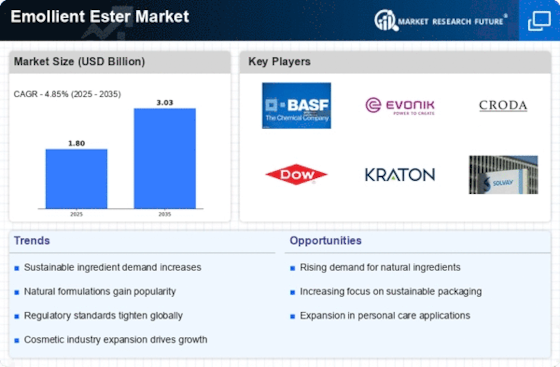Increased Awareness of Skin Health
The Emollient Ester Market is benefiting from a heightened awareness of skin health among consumers. As individuals become more informed about the importance of skin care, there is a growing demand for products that provide hydration and protection. Emollient esters play a crucial role in formulating products that enhance skin barrier function and retain moisture. Recent studies suggest that The Emollient Ester is projected to reach USD 200 billion by 2026, with emollient esters being a key ingredient in many formulations. This increasing focus on skin health is likely to bolster the Emollient Ester Market, as manufacturers respond to consumer demands for effective and beneficial skin care solutions.
Rising Demand for Natural Ingredients
The Emollient Ester Market is experiencing a notable increase in demand for natural and organic ingredients. Consumers are becoming more conscious of the products they use, leading to a shift towards formulations that incorporate plant-based emollients. This trend is driven by a growing awareness of the potential harmful effects of synthetic chemicals. According to recent data, the market for natural personal care products is projected to grow at a compound annual growth rate of 9.5% over the next five years. This shift towards natural ingredients is likely to propel the Emollient Ester Market, as manufacturers seek to align their offerings with consumer preferences for safer and more sustainable options.
Innovation in Formulation Technologies
The Emollient Ester Market is experiencing a wave of innovation driven by advancements in formulation technologies. Manufacturers are increasingly exploring new methods to enhance the performance and sensory attributes of emollient esters. This includes the development of novel ester blends that offer improved stability and skin feel. Market Research Future indicates that the formulation technology segment is expected to grow at a rate of 8% annually over the next five years. As brands strive to differentiate their products in a competitive landscape, the emphasis on innovative formulation technologies is likely to propel the Emollient Ester Market forward, enabling the creation of high-performance products that meet evolving consumer demands.
Regulatory Support for Safe Ingredients
The Emollient Ester Market is positively influenced by regulatory support for the use of safe and effective ingredients in personal care products. Regulatory bodies are increasingly emphasizing the need for transparency and safety in cosmetic formulations. This has led to a rise in the adoption of emollient esters, which are often regarded as safer alternatives to traditional emollients. The regulatory landscape is evolving, with many countries implementing stricter guidelines for cosmetic ingredients. This trend is likely to enhance consumer confidence in products containing emollient esters, thereby driving growth within the Emollient Ester Market as brands seek to comply with these regulations and meet consumer expectations.
Expansion of Personal Care and Cosmetic Applications
The Emollient Ester Market is witnessing significant growth due to the expansion of personal care and cosmetic applications. Emollient esters are increasingly utilized in a variety of products, including lotions, creams, and hair care formulations. The versatility of these esters allows for enhanced texture and skin feel, which is highly valued by consumers. Market data indicates that the personal care segment is expected to account for over 40% of the total emollient esters market by 2026. This expansion is likely to drive innovation and product development within the Emollient Ester Market, as brands strive to create unique formulations that cater to diverse consumer needs.

















Leave a Comment